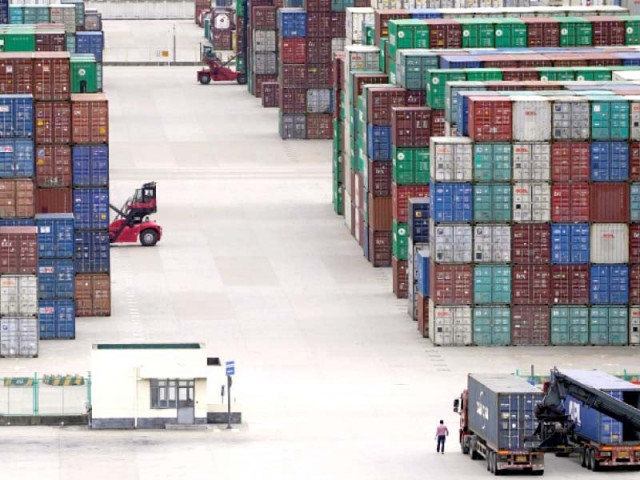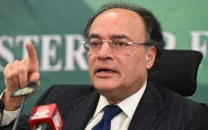Exports touch record high at $2.9b
Ballooning imports, however, pose risk to country’s improving earnings

The government’s efforts to enhance exports are bearing fruit as Pakistan’s foreign shipments soared to an all-time high in November, however, ballooning imports pose a risk to the country’s earnings.
In November 2021, Pakistan’s exports surged to $2.9 billion as compared to $2.17 billion in the same month of previous year, showing an increase of 33% year-on-year and 18% month-on-month, Adviser to Prime Minister on Commerce and Investment Abdul Razak Dawood revealed on his official Twitter handle on Wednesday.
“Our export target for the month (November) was $2.6 billion,” he said and highlighted that exports increased 27% on a year-on-year basis to $12.37 billion in the first five months (July-November) of current fiscal year.
Talking to The Express Tribune, Arif Habib Commodities CEO Ahsan Mehanti appreciated the growth trend and said that surging exports were a good sign for the economy, as they created employment, improved the gross domestic product (GDP) and fetched foreign exchange.
“As a result, the rupee is likely to stabilise given the soaring export numbers,” he said.
However, the CEO predicted that the country’s imports would swell as well in the face of raw material shortage. “Exports increased mainly because of rupee depreciation,” he remarked.
Echoing similar views, Pak-Kuwait Investment Company Head of Research Samiullah Tariq projected that imports would shoot up to around $7 billion, so the trade deficit would be close to $4 billion.
Endorsing the prediction, Arif Habib Limited Head of Research Tahir Abbas told The Express Tribune that assuming a trade deficit of around $4 billion and remittances of $2.5 billion, it was expected that the current account gap would touch $1.4 billion for November.
Topline Securities economist Atif Zafar said that export growth was good, but it was mostly driven by higher global commodity prices.
Although import figures had not been released yet, they were expected to touch $7 billion, which would result in a trade deficit of $4 billion. “It will be a record deficit,” he remarked.
Referring to data of the Ministry of Planning and the Pakistan Bureau of Statistics (PBS), economist Khurram Schehzad underlined that exports had increased in terms of value and not in terms of volume.
“It means global commodity prices are driving the value of exports, otherwise our export volumes are down,” he said, adding that exports would have actually declined had global prices not gone up.
On the flip side, imports were increasing significantly, which would widen the trade deficit, he said.
“Exports alone do not reflect anything. It is the entire net impact that matters by taking imports into account as well.”
“If monthly exports are the highest ever, imports may be the highest ever too,” Schehzad maintained.
Earlier in November, the adviser on commerce stated that the Ministry of Commerce was keeping a close watch on imports and there was a need to work closely with the State Bank of Pakistan (SBP) to curb imports of non-essential items.
He made these remarks while chairing a meeting held to discuss the import of goods during the current fiscal year and its impact on trade and current account deficits.
Meeting participants said that imports increased 64% to $24.99 billion during July-October 2021 against $15.19 billion in the same period of previous year.
In absolute terms, the net increase in imports over the four-month period was $9.801 billion.
It had been observed that around 40% of the increase was in investment-driven imports, such as raw material and intermediate goods, they said, adding that the increase indicated that industrial activity was picking up in the country.
The rise in the import of capital goods, including machinery, reflected industrial expansion, upgrade and setting up of new industrial units.
In the long run, these imports were important for economic growth and job creation, they highlighted.
When asked about the remaining 60% of imports, they said that the imports mainly consisted of energy (petroleum, coal and gas), which had a share of 34%, while vaccines had 11% share, food 8%, consumer goods 2% and others 5%.
Most of these imports were inelastic in nature, the meeting participants said.
The import of consumer goods consumed $239 million, food items $823 million, capital goods $1,620 million, raw material and intermediate goods $2,209 million, petroleum, coal and gas $3,364 million, vaccines $1,068 million and others $478 million.
Meeting participants highlighted that Pakistan’s non-energy import bill decreased 12.5%, or $624 million, in October 2021 compared to September 2021.
On the occasion, Dawood directed the officials attending the meeting to work closely with the SBP on curbing imports of non-essential goods.
Published in The Express Tribune, December 2nd, 2021.
Like Business on Facebook, follow @TribuneBiz on Twitter to stay informed and join in the conversation.



















COMMENTS
Comments are moderated and generally will be posted if they are on-topic and not abusive.
For more information, please see our Comments FAQ